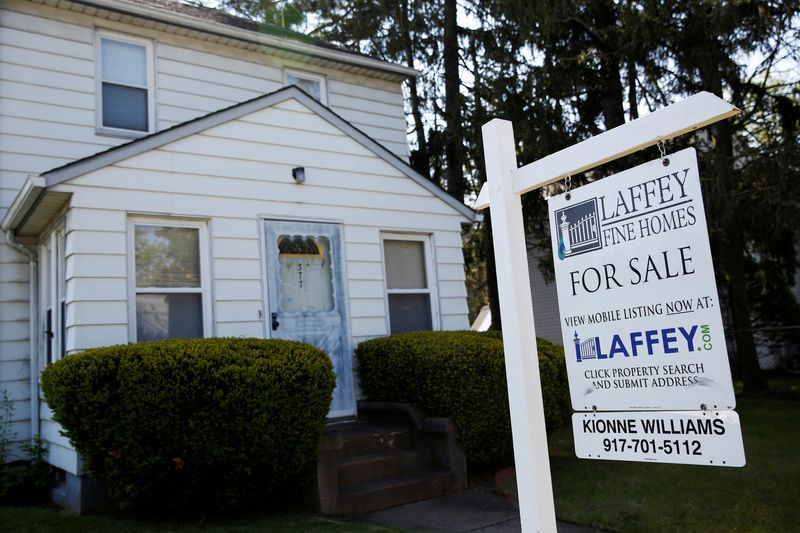By Lucia Mutikani
WASHINGTON (Reuters) -U.S. existing home sales increased to a 10-month high in December, but further gains are likely to be limited by elevated mortgage rates and house prices, which are keeping many prospective buyers on the sidelines.
Despite the bigger-than-expected rise reported by the National Association of Realtors on Friday, home sales in 2024 were the lowest in three decades. The median house price last year hit a record high of $407,500. While housing supply has improved, it remains below pre-pandemic levels.
"With mortgage rates close to 7% and generally soft homebuying sentiment, strength in existing home sales is unlikely to be sustained," said Alice Zheng, an economist at Citigroup (NYSE:C). "We do not expect much further upside for housing demand near-term."
Home sales rose 2.2% last month to a seasonally adjusted annual rate of 4.24 million units, the highest level since February. Existing home sales are counted at the closing of a contract, and December's sales likely reflected transactions that took place at least three months earlier when mortgage rates were relatively low.
Economists polled by Reuters had forecast home resales would rise to a rate of 4.19 million units.
Sales increased in the densely populated South, the West and Northeast, but fell in the Midwest. Sales surged 9.3% on a year-on-year basis, the largest gain since June of 2021, mostly driven by transactions for houses worth $500,000 and above.
A total of 4.06 million previously owned houses were sold last year, the lowest number since 1995.
A survey from mortgage finance agency Fannie Mae (OTC:FNMA) on Wednesday predicted weak existing home sales in the first half of the year, noting that "new homes are now priced competitively with existing homes and are far more available." It forecast the popular 30-year fixed-rate mortgage would average 6.7% in the first quarter and edge down to 6.6% in the second quarter.
Mortgage rates increased late last year in tandem with U.S. Treasury yields, which have jumped amid economic resilience, especially in the labor market, and investor worries that President Donald Trump's plans for tax cuts, broad tariffs and mass deportations could fan inflation.
The Federal Reserve has scaled back its projected interest rate cuts for this year to only two from the four it estimated in September, when it launched its policy easing cycle. The average rate on a 30-year fixed-rate mortgage is just below 7% having risen from as low as 6.08% at the end of September.
The U.S. central bank's cautious approach to rate cuts this year was underscored by a separate report from S&P Global showing a rise in inflation in January, with businesses paying higher prices for inputs and passing on the increased costs to consumers.
Consumers' inflation expectations also jumped in January, a report from the University of Michigan showed, amid fears of higher prices for goods should the Trump administration press ahead with tariffs on imports.
Consumers' one-year inflation expectations rose to an eight-month high of 3.3% from 2.8% in December. Long-run inflation expectations climbed to 3.2% from 3.0% last month. Progress lowering inflation to the Fed's 2% target has virtually stalled, though underlying price pressures subsided in December.
AFFORDABILITY HEADWINDS
U.S. stocks were trading slightly lower. The dollar slid against a basket of currencies after Trump said on Thursday his conversation with Chinese President Xi Jinping last week was friendly and he thought he could reach a trade deal with China. Trump has, however, promised tariffs on Canadian and Mexican goods in February. U.S. Treasury yields declined.
"Inflation data make it unlikely that the Fed will cut rates at the March meeting and the probability of a cut in May is a coin flip," said Jeffrey Roach, chief economist at LPL Financial (NASDAQ:LPLA). "As rates remain elevated, housing affordability will be a major headwind for potential homebuyers."
While the stock of houses on the market has improved compared to 2023, entry-level homes remain scarce. That is keeping home prices elevated.
The median existing home price shot up 6.0% from a year earlier to $404,400 in December. It increased 4.7% to a record high of $407,500 in 2024. Most of the single-family homes sold in December were in the $250,000-$750,000 price range.
Housing inventory fell 13.5% to 1.15 million units last month, which is typical in winter. Supply increased 16.2% from one year ago. Inventory needs to rise by roughly 30% to return to pre-pandemic levels.
At December's sales pace, it would take 3.3 months to exhaust the current inventory of existing homes, up from 3.1 months a year ago. A four-to-seven-month supply is viewed as a healthy balance between supply and demand.
Properties typically stayed on the market for 35 days in December, compared to 29 days a year ago. First-time buyers accounted for 31% of sales versus 29% a year ago. They made up a record low of 24% in 2024. Economists and realtors say a 40% share is needed for a robust housing market.

All-cash sales constituted 28% of transactions last month, down from 29% a year ago. Distressed sales, including foreclosures, represented only 2% of transactions, unchanged from last year.
"The upshot is that buying activity should remain stagnant," said Ruben Gargallo Abargues, an assistant economist at Capital Economics.